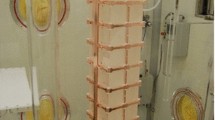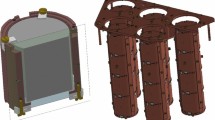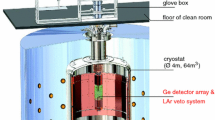Abstract
The Cryogenic Underground Observatory for Rare Events (CUORE) is the first bolometric experiment reaching the 1-ton scale. The detector consists of an array of 988 TeO2 crystals arranged in 19 towers. The construction of the experiment and the installation of the detector was completed in August 2016. In this paper, the technical challenges of the construction, the design choices and measured performance of the electronic instrumentation are presented.
Access provided by CONRICYT-eBooks. Download conference paper PDF
Similar content being viewed by others
1 Introduction
Although in the Standard Model neutrinos are classified as Dirac massless particles, the discovery of neutrino oscillations [1] revealed that neutrinos are massive thereby provided the first evidence of new physics. Nevertheless, oscillations do not give information about the absolute mass scale of the neutrino nor about the hierarchy of its different mass states. Moreover, there is no evidence whether neutrinos are Dirac or Majorana particles, i.e. if they are their own antiparticles. Neutrinoless double-beta decay \( \left( {0\nu \beta \beta } \right) \) has the unique potential to provide insight into the above issues. This extremely rare \( \left( {T_{1/2}^{0\nu }{\sim}10^{25}{-}10^{26}\,{\text{yr}}} \right) \) lepton-number-violating process consists of two simultaneous beta decay in which the two neutrinos annihilates, so that only the two electrons are emitted from the nuclide. Unlike the double beta decay, the energy spectrum of two electrons produced in the \( 0\nu \beta \beta \) results in a narrow peak at the Q-value, whose resolution is only limited by the detection performance. Experimental evidence the \( 0\nu \beta \beta \) would provide information about the neutrino mass hierarchy and absolute mass scale from decay half-life.
One of the most important figure of merit of such experiments is the sensitivity (S0v), defined as the life-time corresponding to the minimum detectable number of events over the background at a given confidence level. In the approximation of non-zero background, S0v increases proportionally to the isotopic abundance of the radionuclide of interest, to the square root of the detector mass and experiment life-time, and inversely proportional to the square root of the energy resolution at the Q-value and the background index, i.e. the number of spurious events per unit of energy, time and mass at the Q-value. In order to push the sensitivity up to 1025–1026 yr, very large masses must be observed for several years and excellent energy resolution and extremely low background must be achieved. The Cryogenic Underground Observatory for Rare Events, CUORE [2], is the first ton-scale experiment that searches the \( 0\nu \beta \beta \) in 130Te. In this paper, an overlook on the design and status of CUORE is described, including the detector assembly and the cryogenics commissioning. A brief overview on the electronic system is also provided in Sect. 3.
2 The CUORE Experiment
CUORE is a bolometric experiment located in the Hall A of the underground Laboratori Nazionali del Gran Sasso (LNGS), Italy, which offers a covering of \( \sim \)3700 m.w.e. (meter water equivalent) above the experimental area. The CUORE detector consists of an array of 988 TeO2 bolometers arranged in a compact cylindrical configuration of 19 towers, each made from the assembly of 4 columns of 13 crystals each, so that a single tower hosts 52 cubic bolometers, 5 × 5 × 5 cm3 each. The base blocks composing a bolometer detector and are shown in Fig. 1. Each crystal is equipped with a Neutron Transmutation Doping (NTD) thermistor, a sensor whose resistivity exponentially depends on the operating temperature. A heating resistor is also thermally coupled to the bolometer to provide a reference signal for the detector response stabilization. Bolometers are particularly suitable for the search of \( 0\nu \beta \beta \) decay as they ensure an excellent energy resolution, no dead layers, wide choice of materials and the potential to compose ton scale detectors.
CUORE uses TeO2 cubic bolometer of 750 g each, with a thermal capacitance of ~2 nJ/K at ~10 mk. The excellent performance of such crystals was already demonstrated by the pilot experiment CUORICINO [3], which also represented a fundamental phase to refine all the stages for the CUORE tower construction. The crystals were placed in a clean room where a custom-made robotic arm glued both the thermistor and the heater on the crystals. The towers were assembled in a glow box where the copper structure, the teflon supports of the crystals and the flat cable for the electrical system were mounted. Finally all the sensors and heaters were bounded to the electrical pads. After the assembly, the towers were kept inside boxes fluxed with nitrogen. The towers were finally installed inside the cryostat during August 2016, in a controlled radon-free atmosphere. All these steps allow to achieve an extremely high radiopurity level (background goal: \( B\sim 10^{ - 2} \;{\text{keV}}^{ - 1} {\text{kg}}^{ - 1} {\text{yr}}^{ - 1} \)). The ~1 ton detector was cooled down at the baseline temperature of ~10 mk in January 2017. In order to achieve such low temperature and long term stability, a custom dilution refrigerator was designed and commissioned in March 2016. The cryostat is mechanically decoupled from the detector by means of a multi-stage suspension system in order to avoid that frictions could inject thermal power. The target energy resolution of CUORE is \( \sigma_{\text{E}} /{\text{E}}\,{ < }\, 1 0^{ - 3} \), which corresponds to 5 keV FWHM at \( {\text{Q}}_{\text{Te}} = 2528\,{\text{keV}} \).
3 The Electronic System
The main tasks the electronic system must fulfill is the detector bias, the signal read-out, its amplification and the stabilization of the detector response. As the detector is supposed to run for several years, an extremely high stability is needed. Furthermore, the electronic noise must be minimized as it spoils the achievable energy resolution. The power supply for the electronic system and the stable and low noise reference for the detector bias is provided by a three stage chain: a Lambda programmable AD/DC converters, from TDK, feeds a custom designed, low noise DC/DC converter. To filter the residual ripple noise, a linear power supply has been developed to provide the front-end bias [4]. This equipment is located at the top of the cryostat, inside a Skudotech Faraday cage, and connected to the low temperature crystals by a twisted pair cable. By using such architecture, most of the low frequency microphonic noise results in a common mode signal among the twisted pair and it can be rejected by the fully differential, low noise, front-end system [5]. The signal is acquired by a voltage sensitive pre-amplifier feeding an adjustable gain amplifier. The signal is finally filtered by a Bessel stage that optimizes the signal-to-noise ratio and behaves as anti-aliasing filter before the digitization. The full system is remotely controlled and managed by an optically decoupled slow monitoring system. The whole equipment was installed during 2016 and the optimization of the electronic operational parameters and the detector working point was completed in late 2016. Figure 2 shows one of the first pulses acquired by the CUORE experiment in January 2017.
Temperature fluctuations usually occur in cryogenic experiment and affect the response of bolometers and thermistors. The electronic system is equipped with an apparatus able to provide a very stable voltage step across the heaters, so that a thermal pulse can be injected to the bolometers. Such pulses are used as reference signal to compensate for the gain drifts. The pulser boards have been designed to achieve an energy resolution of ~2 ppm at 1 MeV and each board was calibrated to ensure a thermal drift of ~0.1 ppm/°C in a operating temperature range of 20–60 °C. The efficacy of the described calibrating system is shown in Fig. 3. Data acquired in two different datasets are added to compose the energy spectrum. After the stabilization, the gain fluctuations between the runs are completely compensated and the energy peak can be reconstructed with the expected resolution.
4 Conclusions
This paper presented the status of CUORE, a ton scale experiment researching the neutrinoless double beta decay in 130Te adopting a bolometric technique. The detector installation has been completed successfully, the CUORE cryostat has been commissioned and reached the baseline temperature in January 2017. The electronic system was installed in first half of 2016 and then optimized on-site. The detector working point and setup optimization is going to be completed and the data taking is now commencing.
References
Bellini, G., et al.: Neutrino oscillations. In: Advances in High Energy Physics (2014)
Arnaboldi, C., et al.: CUORE: a cryogenic underground observatory for rare events. Nucl. Instrum. Methods Phys. Res. Sect. A 518(3), 775 (2004)
Arnaboldi, C., et al: Results from a search for the \( 0\nu \beta \beta \)-decay of 130Te. Phys. Rev. C 78, 035502 (2008)
Carniti, P., et al.: Very low noise AC/DC power supply systems for large detector arrays. Rev. Sci. Instrum. 86, 124703 (2015)
Arnaboldi, C., et al.: The design of the input stage for the very front-end of the CUORE experiment. Low Temp. Phys. 151, 964–970 (2008)
Author information
Authors and Affiliations
Corresponding author
Editor information
Editors and Affiliations
Rights and permissions
Copyright information
© 2018 Springer Nature Singapore Pte Ltd.
About this paper
Cite this paper
Cassina, L. et al. (2018). The CUORE Bolometric Detector for Neutrinoless Double Beta Decay Searches. In: Liu, ZA. (eds) Proceedings of International Conference on Technology and Instrumentation in Particle Physics 2017. TIPP 2017. Springer Proceedings in Physics, vol 213. Springer, Singapore. https://doi.org/10.1007/978-981-13-1316-5_38
Download citation
DOI: https://doi.org/10.1007/978-981-13-1316-5_38
Published:
Publisher Name: Springer, Singapore
Print ISBN: 978-981-13-1315-8
Online ISBN: 978-981-13-1316-5
eBook Packages: Physics and AstronomyPhysics and Astronomy (R0)







